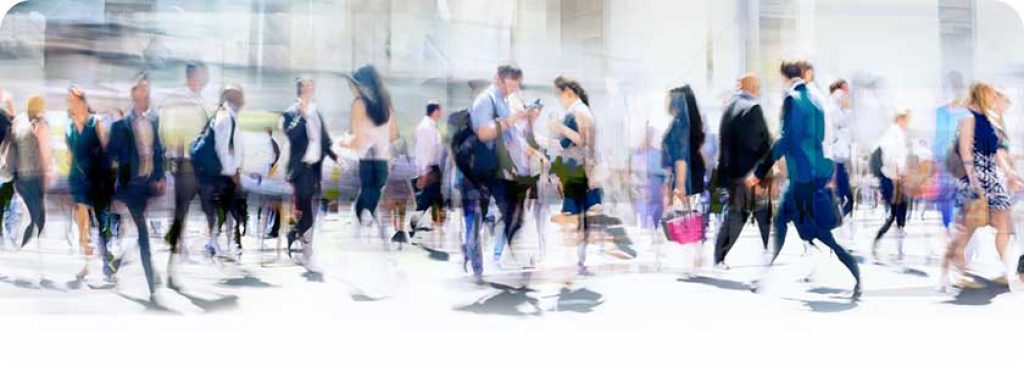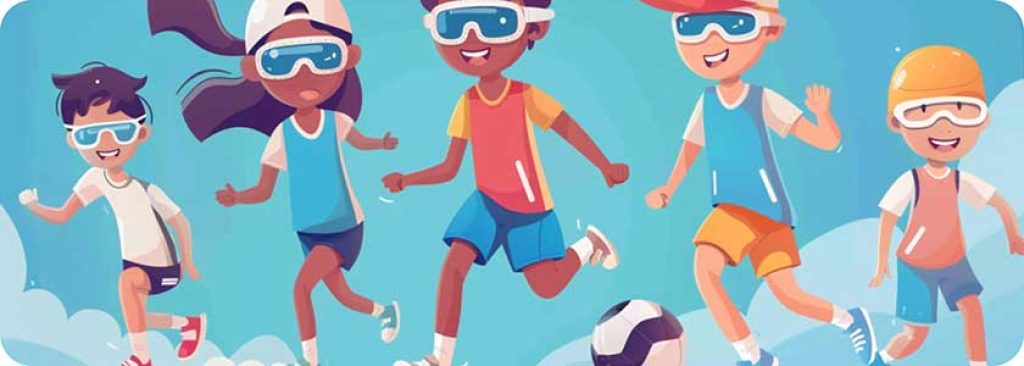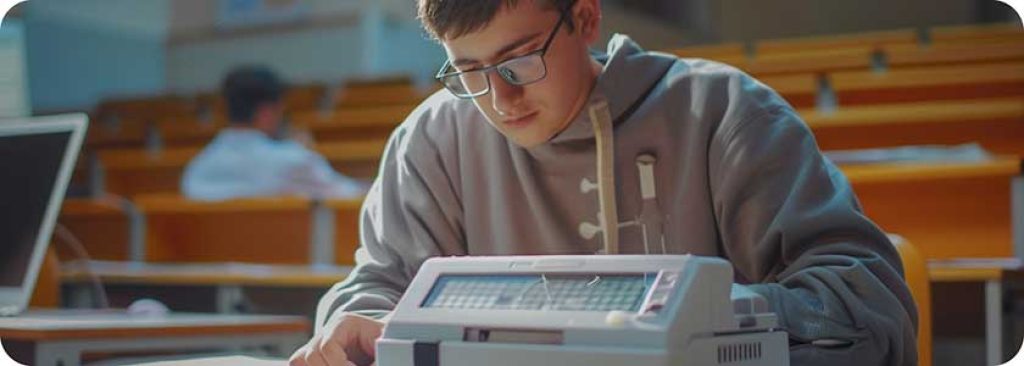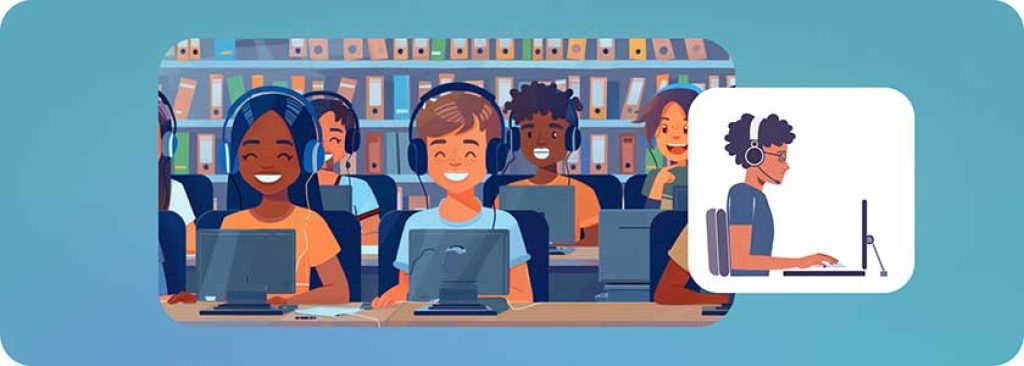Innovative Assistive Technologies for Visually Impaired Students
Innovation in Educational Access for Blind & Low Vision Learning
About 2.2 billion people worldwide experience vision impairment, as estimated by the World Health Organization (WHO) in about 2020, markedly disrupting their daily lives, education, productivity and employment, and as a result, their financial health as well. Almost half of the cases reported by the WHO had vision impairment caused by avoidable disease-related eye damage, including cataracts, age-related macular degeneration (AMD) and diabetic retinopathy, affecting blood vessels in the light-sensitive retinal tissue at the back of the eye. Everyone should get a full dilated eye exam at recommended intervals; for people with diabetes, it’s especially important to schedule an annual exam, and to manage their diabetes with a healthy treatment plan, regular exercise, and good eating habits.
A report by the International Agency for the Prevention of Blindness (IAPB) projects a possible 55% rise in vision loss by 2050. This jump is partly due to an aging population, which is not all bad: it means people will live long enough to develop health concerns due to advanced age, like low vision. But we shouldn’t accept severe visual impairment as a fact of life for anyone.
While not all eye injury and vision loss can be avoided, some can be, and we should do all we can individually and collectively to prevent it. With early detection and treatment, conditions like cataract and glaucoma can be handled in a way that saves sight. And, keeping an eye on vision health is essential at every age. So no matter how old you are, make eye exams and good eye health practices a priority for yourself, your family, and your loved ones.

Vision Loss & Visual Impairment in Young Learners
Vision loss is often thought of as an age-related issue: that’s statistically more likely, but young people are not immune to visual impairment. In the United States, about 6.8% of children under 18 have a diagnosed eye condition, with diminished visual abilities. Almost 3% have full blindness or severe visual impairment, meaning they struggle to see even with corrective lenses. 2021 surveys showed more than 70% of visually impaired students aged 3 to 21 spent upwards of 80% of their school day in classes. At that rate, any vision-caused difficulties are significant.
Common visual problems in this age range that may be congenital or developmental include:
- Refractive errors, that is, blurred vision for far or near objects (hyperopia and myopia), and astigmatism.
- Lazy eye, or amblyopia, where vision in a single eye is limited because of a brain-eye miscommunication. This causes a reliance on the eye that’s working strongly, while the eye with weaker vision deteriorates.
- Crossed eyes, or strabismus, can affect one eye, or both. Strabismus sufferers cannot focus both eyes on the same item at once. This causes problems in coordinating eye positioning.
- Dual-eye coordination difficulty in close-up viewing is called convergence insufficiency. This results in blurring or double vision when the person is looking closely at an item such as a book or digital screen.
Disease and injury can cause sudden and severe vision loss in children, teens and young adults. Conditions like diabetic retinopathy are not always age-dependent, and inherited retinal degenerations and infectious diseases can significantly impact vision. While less common, side effects of certain medications, and even overuse of digital devices causing eye strain can also lead to vision problems in younger age groups.
For children under 18, their parents or legal guardians are responsible for protecting and promoting their eye and vision health. Regular eye exams are a must at all ages, for early detection and intervention, to prevent vision loss or preserve remaining sight. Sunglasses should always be worn in bright light, as should protective eyewear in sports or risky activities: approximately 90% of all eye injuries are preventable by wearing the right eye protection gear. They are usually the simplest and most affordable form of assistive technology for eye protection, for students with or without visual impairment. And, encouraging young people to keep eating plenty of fruits and vegetables is another important way to help keep their vision intact, as they grow, and for life.

Eye Health and Preventive Vision Care During Higher Education
What about students who are no longer on their parents’ health plan, but don’t yet have health care tied to a full-time job? How can these young adults take good care of their vision, and avoid as well as treat eye issues?
In many countries, universities and colleges offer vision care services directly on campus or through partnerships with local eye doctors. These services often include dilated eye exams, to provide a more thorough assessment of eye health. Students should check with their student health center or campus website to determine if eye exams are offered, and if they are covered by student health insurance plans. Alternatively, some student health insurance plans may provide coverage for these thorough eye exams off-campus.
Either type of healthcare plan may often provide additional services such as treatment for eye conditions, pre and post-operative care for those who have had Lasik surgery, contact lens fitting, and eyeglass repairs. Students should explore their options to receive proper eye care and maintain good vision throughout their academic careers.

How Does Visual Impairment Interfere With Schooling?
Visually impaired students encounter significant barriers in education. Traditional course materials and teaching methods, designed for sighted students, frequently leave them at a disadvantage. Participating in group work that relies on visuals can be frustrating. Essential skills like reading fluency, following demonstrations and spatial awareness can also be hampered. Books and printed worksheets or handouts, diagrams, visual aids, and even the teacher's board notes may all be unusable without assistance. Keeping pace with instruction can also be difficult, due to missed visual cues and an inability to copy information quickly. Completing assignments that involve visual elements, from drawing graphs to interpreting maps, may require alternative methods. And standardized testing in typical formats may not be accessible to these students at all.
The inability to perceive visual information creates difficulties in all aspects of school life, from reading textbooks to walking down hallways. Schools that are not designed with accessibility in mind exacerbate the obstacles, making everyday activities a hardship. For students with visual impairment, assistive technology in the classroom can provide much-needed support in navigating physical and digital learning environments.
Blocked By The Blur
Simple tasks that can become more difficult for those with visual impairments, even with glasses or contact lenses:
- Doing any kind of work that requires seeing up close
- Driving during bright daylight hours
- Night driving with lowered visibility
- Finding an item on a cluttered shelf or work desk
- Going down stairs or stepping off a curb in dim lighting or at night
- Noticing objects that are off to one side of the person’s field of vision
- Reading smaller printed text
These obstacles can hinder a student's ability to keep pace with their learning cohort. Recent studies indicate that visually impaired students are less likely to complete higher education compared to their sighted peers. Additionally, the lack of specialized resources and trained support staff in schools further exacerbates the struggle, emphasizing the need for inclusive education practices and accessible learning technologies.
With the right support and assistive technologies, however, students with visual impairments can achieve academic success equal to their sighted counterparts, underscoring the importance of addressing these educational barriers.

Assistive Tech Versus the Learning Gap
Innovative assistive technologies are revolutionizing education for visually impaired students. These tools close the distance between traditional learning materials and a student's ability to access information.
Useful Tech Tool Types For Students With Visual Impairment
Text-to-Speech and Screen Readers
Assistive technology for blind students must begin with a mention of screen reader software like JAWS, NVDA and VoiceOver. These transform digital text into spoken audio which is then announced. With the help of screen readers, visually impaired and blind students of all ages can independently access textbooks, articles, and online learning materials, supporting students in becoming active learners and keeping up with their sighted peers. Other types of text-to-speech technology include NaturalReader or Equinox, programs that allow users to convert text files, web pages, and PDFs into audio files, and Kurzweil 300, offering OCR (optical character recognition) and study skills tools. The Kurzweil 300 is a longstanding favorite among educators, and is highly valued by visually impaired students for its effectiveness in making reading accessible.
Braille Displays and Notetakers
Braille remains a vital form of literacy for many blind individuals. Braille displays translate digital text into refreshable Braille lines, allowing users to read and interact with information. Braille notetakers combine a Braille keyboard with a refreshable display, so students can take notes, write assignments, and manage their studies. These tools are particularly valuable for students who learn best through tactile methods. The Brailliant Notetaker by HumanWare is a refreshable Braille display device that includes text-to-speech, getting it closer to a hybrid Braille display-notetaker. Focus Blue Braille displays by Freedom Scientific are portable braille displays ranging in size and functionality. They connect to computers or mobile devices via Bluetooth. The Orbit Reader 20 Plus is a more cost-effective Braille display, book reader and notetaker that supports reading and writing in Braille.
Magnification Technologies
Software and hardware magnifiers enlarge digital or physical text, making it easier for students with low vision to read. Examples include desktop magnifiers with adjustable zoom functions, or handheld video magnifiers that project magnified images onto a screen. Head-Mounted Displays (HMDs) are wearable devices that can project magnified text or images directly onto the user's retinas: a good option for students who need to be hands-free while magnifying text. Portable video magnifiers are another excellent match for the educational environment. Magnification tools and technology are helpful for students who retain some functional vision.
Educational Apps and Platforms
A growing range of educational apps and learning platforms have been specifically developed to serve the needs of visually impaired students. These tools often incorporate features like text-to-speech narration, audio descriptions, and interactive elements that make learning engaging and accessible. These apps can be used in various learning environments, from elementary school classrooms to university lectures. Learning Ally is a non-profit organization that provides a vast library of accessible audiobooks, helpful for younger students with visual impairments. The Perkins eLearning platform, developed by the Perkins School for the Blind, offers a variety of educational resources for students with visual impairments, including courses, tutorials, and interactive activities. Perkins eLearning is designed to be accessible with screen readers and other assistive technology for visually impaired or blind students.
Tactile Graphics and 3D Printing
For understanding graphs, charts, and other visual aids, tactile graphics and 3D-printed models provide a real perceptual alternative. These tools allow students to explore and learn from physical representations of complex information, an approach that is valuable for students of all ages, from children first encountering science concepts to adults pursuing advanced degrees.
Audio Navigation and GPS Technology
For visually impaired students navigating a school campus or any unfamiliar location, audio navigation apps and GPS technology provide necessary assistance. These tools offer turn-by-turn directions and descriptions of surroundings, supporting greater independence and mobility. The BlindSquare app can be used on iOS devices to leverage GPS capabilities to identify location and offer information on surroundings, with useful features including the ability for users to mark personalized points of interest.
Smart Classroom Technologies
Smart classroom technologies are not entirely new, but they are developing in new ways that support inclusive learning. Interactive whiteboards with screen reader compatibility and real-time captioning can mean that all students are learning the same lesson. These advancements pave the way for a more equitable learning experience for all students, regardless of their visual abilities.
Building Inclusive Classrooms & Student Confidence
The transformative impact of assistive technologies cannot be overstated. Students who are blind or visually impaired are no longer limited by inaccessible learning materials. These tools help them to actively engage with coursework, develop critical thinking skills, and pursue their academic goals.
Assistive technologies equip visually impaired students with the skills and abilities to become lifelong learners as well as successful participants in the world outside academia. By offering alternative methods to access information and engage in the learning process, these tools cultivate a more inclusive and enriching educational environment.
As blind and low vision assistive technology continues to develop and evolve, it represents a powerful force for inclusivity within education, an ever-expanding array of accessible tools that offers visually impaired and blind students an equal chance to excel academically and pursue a bright future. By integrating these innovations, educational institutions pave the way for a generation of lifelong learners where ability knows no bounds.

FAQs
The cost varies, but yes, they can run high. However, many government programs, educational institutions and advocacy organizations offer financial assistance to students with disabilities.
Most assistive technologies are designed to be user-friendly, but there can be a learning curve, depending on the specific tool. Many training programs and resources are available to help students learn and master these tools.
This will depend on the individual student's needs and learning style. Factors to consider include the student's age, visual acuity, and preferred learning methods.
Yes, tech like tactile graphics, 3D printing, and specialized software can offer ways through assistive technology for visually impaired students to understand complex scientific and mathematical concepts by providing accessible ways to interact with diagrams, equations, and spatial information.
By collaborating with educators and specialists to identify the tools that best meet their child's educational needs and preferences, and, if appropriate for their age and level of understanding, by inviting the child to consider options.
This will depend on the individual student's needs and learning style. Factors to consider include the student's age, visual acuity, and preferred learning methods.









